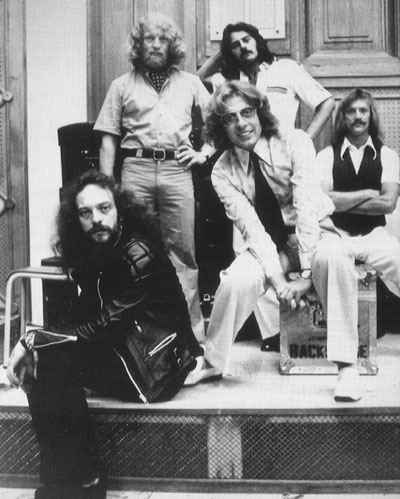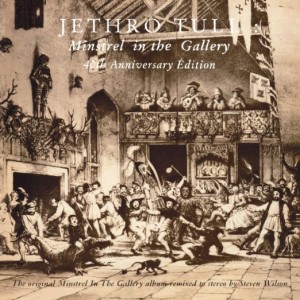Jethro Tull, again? Seriously? Yes, seriously.
The reason Tull warrants continued discussion is because unlike just about all other prog rock acts of the mid-‘70s, they were—in their businesslike, seemingly obligatory fashion—cranking out one masterful effort each year.
In 1975, progressive rock was, we now know with the benefit of hindsight, already on its way to the dinosaur pit. Pink Floyd was, arguably, hitting their prime stride, releasing possibly their most cohesive and satisfying album Wish You Were Here, but many other acts from the great old days were on the ropes, running out of steam or gone altogether. Yes was on a hiatus, Emerson, Lake & Palmer and The Moody Blues were not dead but shells of their former selves, Rush was just getting into the game, and King Crimson had called it quits. Genesis soldiered on, and made a string of respectable albums with Collins at the helm (and then made a longer string of increasingly commercial, successful albums), but many would agree that things were never the same once Peter Gabriel rolled up his freak flag and went it alone.
So, aside from Pink Floyd, who were now an album every-other-year (at best) outfit, Jethro Tull were the kings of the hill, in terms of consistency and quality. The benefit of hindsight makes their proficiency, and the quality of the work, more obvious and more important to acknowledge. Where some (much?) of the material from prog rock’s heyday is decidedly of its time (for better or worse) and, lyrically, is often acknowledged with a wink and a shrug, Jethro Tull’s work in general, and on Minstrel in the Gallery in particular, needs no defense nor any nostalgia to be appreciated.
One of the reasons the genre seemed stale or at least more than a little played out, circa 1975 (hello Emerson, Lake & Palmer), is because the formula was no longer sufficient to inspire fresh work, or at least be heard with fresh ears. Indulgence for indulgence’s sake was rightly losing favor with a wider audience, and at the mid-way point of a new decade, new approaches were necessary. As the first punk bands proved, a radically different approach would be rewarded. Punk, with its lo-fi lack of proficiency or pretense, was in almost every regard anti-prog (for better or worse).
So Jethro Tull, never especially fashionable, soldiered on without much regard for critical acclaim from the so-called establishment, powered by the industrious engine of Ian Anderson, who was just hitting his stride.
Discussion of Anderson’s lyrical prowess is inevitable, and appropriate, and mentioned in previous reviews. Where he did not shy away from autobiographical elements (especially on Benefit), his specialty was linking the personal with a reporter’s eye for both absurdity and the universal (especially on Aqualung); on Thick as a Brick he displays a sociologist’s eye for societal mores, and in his inimitably impish way, took his sledge hammer to all manner of very British sacred cows (class, religion, etc.); on A Passion Play he used every tool in his musical and intellectual arsenal. On Minstrel in the Gallery we have less of the sneering post-adolescent angst and rage and more of the wizened perspective of an adult who has toured the world, seen some things and is able to comment accordingly.
If the title track is a bit too literal (get it? The musician seeing himself in the crowd…), it’s also a tour de force of sorts that, in Andersonian fashion, takes the piss out of the cult of self/celebrity while also offering some quite poetic observations on the ways artist and audience interact:
The minstrel in the gallery
Looked down on the rabbit-run
And he threw away his looking-glass
He saw his face in everyone
Anderson, who has always been an underrated acoustic guitar player (most folks, understandably, see him as the wide-eyed and one-legged flautist), started pushing himself, notably during the band’s Holy Trinity. While his work, pound for pound, on A Passion Play may be his best, Minstrel in the Gallery represents his most singular and sustained acoustic achievement: his work throughout is memorable and masterful.
It would be a mistake to describe this as either an acoustic or restrained affair, as evidenced by “Cold Wind to Valhalla” (containing some of Martin Barre’s tastiest shredding), as well as the rocking sections of the title track and “Black Satin Dancer”, but the acoustic is ever-present and it’s easy to see how these tunes grew from solo excursions to full collaborations. If it’s once again necessary to single out drummer Barrie Barlow for the way his busy sticks augment and embellish the proceedings to delightful effect, than let it once again be stated.
The secret weapon here, more so than any earlier album, is David Palmer, previously employed to judicious and exhilarating effect (think the soaring orchestral flair toward the end of Thick as a Brick, or the subtle, gorgeous string embellishments on “Reasons for Waiting”) is now a full equal; for the first time it’s both appropriate and accurate to draw comparisons to what George Martin was doing for The Beatles: not “merely” adding dignified touches here and there or inserting informed color commentary at key moments, but completely in the mix, the orchestral effects as important as the guitars and keyboards. (Not for nothing, either, since this album is so heavy on the acoustic touches, the fastidiously remastered sound does, indeed, bring out nuances and touches not previously detectable.)
Palmer takes already remarkable compositions to that rarefied “other place” on the album’s twin highlights, “Requiem” and “Baker St. Muse”. On the former, a gentle tone poem, we can now appreciate, courtesy of the previously unreleased early version, the way this simple (sounding) song evolved from whimsical allegory to a fully realized and devastating take on the clichéd romantic break-up. (Initial lyrics describe a leaf; the final song replaces the leaf with a bird, which of course works as British double entendre for a woman).
Well, my lady told me, “Stay”
I looked aside and walked away along the strand
But I didn’t say a word, as the train time-table blurred
Close behind the taxi stand:
Saw her face in the tear-drop black cab window
Fading in the traffic watched her go,
And taking in the morning, heard myself singing, “Oh Requiem”
Here I go again, it’s the same old story…
Well, I saw a bird today, I looked aside and walked
Away along the strand.
As with previous Steven Wilson-supervised special editions, we get refined sound courtesy of the 5.1 surround and remix, as well as a truly generous and authoritative booklet complete with lyrics, anecdotes and interviews. Much of that material ranges from quirky to superfluous but, of course, insight from the actual band proves priceless. Most fans will concur that Minstrel in the Gallery seems as autobiographical as any Tull album, before or after, and there is a vulnerability and sensitivity that the songwriter (obviously, with hindsight) was simply growing into.
Anderson himself provides salient insight into his writing process, and also does a service for anyone who has tried to understand (or explain) the impulse to turn the “personal” into something less self-involved and applicable: “As a lyric writer I think that leaving some space is an important ingredient, that you don’t answer all the questions in the lyrics, you do leave the listeners to put something of themselves into the scenario and think about it in the light of their own experiences, or indeed experiences they’ve not yet had.” (Liner notes.)
Perhaps the finest distillation of the aforementioned reportorial eye, balancing obvious autobiography with imagination, is “Baker St. Muse” which, put plainly, showcases Anderson and his band at an absolute pinnacle of composition and execution. Polite golf-claps all around (but more, as ever, reserved for Barre and Barlow), an especially hearty hurrah for Palmer, and all-time hero status for Anderson, who would never again display this combination of brilliance, confidence and creative attainment. It could be considered (yet another) semi-side long suite, or else an epic prog statement (like Thick as a Brick or A Passion Play) in miniature, or it could, correctly, be appraised and appreciated on its own terms: a story of how the present-day minstrel prowled the streets looking about for explanations, or at least inspiration. We see the (usual?) parade of freaks and outcasts but, for once, the songwriter turns the microscope on himself and we see some of the concerns and obsessions that feed that distinctive muse.
For anyone curious, but unsure, about whether this 40th Anniversary edition is a compulsory acquisition, consider the (requisite) bonus discs. As mentioned, there is the 5.1 remaster and the Steven Wilson remix; there’s also a complete concert from July 1975 (Paris) that has never before been available. On one hand, it’s yet another sampler of hits (“My God”, “Cross-Eyed Mary” and, of course, “Aqualung”) but on the other, it’s a document of one of the best Tull line-ups. There are also the odds and sods of demo versions and out-takes (like the delightful lark “Summerday Sands” and, even though, like the master take, it’s less than one minute long, the alternate version of “Grace” is a special treat for Tull enthusiasts.
To summarize, these annual remaster projects are appropriate because Jethro Tull was making an album every year in the ‘70s; they are necessary because even people who tolerate prog rock or give it a courteous mention still limit themselves to a handful of “classic” albums that few people will protest. One need not be a prog aficionado to understand that many outstanding efforts were produced as a matter of course in the early and mid-‘70s; Minstrel in the Gallery is one of them and it’s a crime to think fans who think they know aren’t aware of this near-masterpiece.
*Originally published 8/5/15 in PopMatters, my latest installment for my series on prog rock, The Amazing Pudding.


